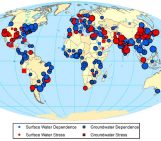
by Tara Forstner, University of Victoria
I recently wrote a term paper for one of my graduate classes on the limitations of the water table fluctuation (WTF) method, and I have to say, WTF!
Techniques using groundwater level fluctuations as a means of calculating recharge are very common. With observation well hydrographs and precipitation data, this method can be applied quite simply, requiring no field work or data collection. Although, this is definitely not the method to end all recharge methods for a number of reasons. As a newbie hydrogeologist studying the WTF method, the application of the method quickly became convoluted based on its limitations and uncertainties.
My term paper focused mainly on the WTF method as described by the classic papers by Healy and Cook (2001), and Cuthbert’s novel estimation of drainage (Cuthbert, 2010) and straight line recession (Cuthbert, 2014). Here is a list of the three most important things I learned:
- Developing a good conceptual model of the region is essential for the success of this method, as large uncertainties entail if effects of pumping, proximity to surface water bodies, water table depths, and geology are not considered. With the water table fluctuating based on several factors, it becomes essential to investigate possible influences.
- The WTF method has two main approaches; (a) to solve for a time series model of recharge, or alternatively, (b) to calculate a long term average recharge value from the groundwater recession constant. The time series approach is best used to observe fluctuations of recharge in response to precipitation over a smaller temporal scale compared to the long term average recharge value calculated from the groundwater recession constant.
- Simply ‘plugging in’ the values or using computer programs to estimate drainage recession constant could seriously warp the ‘real’ recharge value. Mark Cuthbert mentioned to me in a discussion that he still prints off the hydrographs and often plots the groundwater recession by hand in order to help visualize the groundwater recession before taking a computing approach.
In closing I thought I would share one of my silly ‘WTF!?’ moments and that ‘oooooohhh’ moment that follows once I figured it out. In Healy and Cook (2002), the formula for recharge is written as R = Sy dh/dt, and later in Crosbie (2005) as R = Dh Sy and Cuthbert (2010) as R = Sy dh/dt + D. There are two things that tripped me up with this method. Firstly, the meaning of the symbols R and Dh varies slightly between papers which is easy to miss, and recharge is either calculated as a rate or a value over a specified time. Secondly, the approach in deriving the groundwater recession constant is also different in all three papers, and should be chosen on the basis of the conceptual model.
So alas, the WTF can definitely have it’s ‘WTF!?’ moments, however when the method, possibilities, and limitations are properly understood, this method has the potential of providing a cost effective and non-invasive approach in deriving recharge values.




